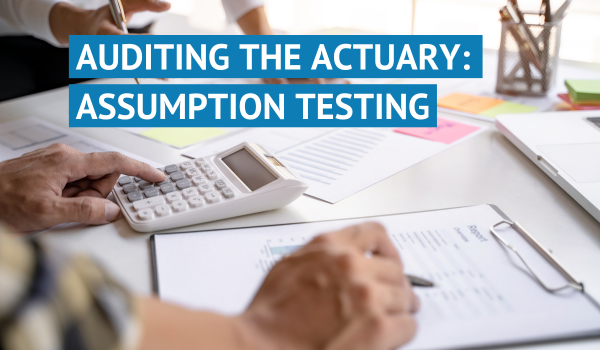Auditing the Actuary: Assumption Testing
March 20, 2024|Kurtis Thompson

Bottom Line Up Front
- GASB standards require auditors to “Audit the Actuary,” scrutinizing pension and OPEB valuations, but ambiguity surrounds this requirement
- Auditors must assess the reasonableness of actuarial assumptions individually and collectively, posing a challenge without developing a full actuarial model.
- Below are various methods for auditors to prioritize and test the reasonableness of assumptions in actuarial valuations that are essential for compliance and accuracy.
GASB standards concerning Pension and OPEB valuations have placed a burden on auditors to “Audit the Actuary,” but the exact meaning of this requirement is left with some ambiguity. It seems obvious that as auditors, you shouldn’t need to become an actuary, diving into the ins and outs of actuarial valuations. However, you must demonstrate that you are indeed scrutinizing these valuations. While we’ve previously covered census testing for auditors, this article will delve into methods auditors can employ to assess the assumptions underlying
The benchmark for an actuary’s assumptions is that each assumption should be individually reasonable, and collectively, the assumptions should be reasonable in the aggregate. From an auditor’s standpoint, it’s far easier to evaluate assumptions individually, because it is very difficult to measure the reasonableness of assumptions in aggregate without developing a full actuarial model. So, which assumptions should you prioritize, and what methodologies can you use to test the reasonableness of these assumptions in actuarial valuations?
1. Prioritizing Key Assumptions
There are many assumptions that go into an Actuarial valuation, but some have significantly more impact than others. Thus, your audit energy is better spent reviewing the assumptions that count the most.
Discount Rate
GASB specifies for both OPEB and Pension plans how to calculate the discount rate. The main role of the Auditor is to ensure the Actuary is applying the GASB standards to the development of the discount rate in a way that is consistent with the appropriate standards. This may include a review of the crossover date analysis as well as projected contributions and withdrawals from the Trust if one exists. Review the reasonableness of the assumed rate of return on assets.
Trend Rate (Medical Trend for OPEB, Compensation Increase for Pension)
Trend rates are generally not prescribed by law or by GASB standards so there is more room for the Actuary’s interpretation. An audit of assumptions that are not prescribed by law means asking the question, “Is this assumption reasonable?” The standard of reasonableness is left up to the interpretation of the Auditor and the Actuary.
Fortunately, GASB standards say the Actuary should provide a sensitivity analysis on these two major assumptions showing the impact on Liability and Service Cost if they were 1% higher or lower. That will help with gauging the impact of these assumptions on the valuation and the level of scrutiny that they deserve.
2. Mandated Assumptions
Some assumptions are established by state law or by standards set by GASB/FASB, which outline the assumptions to be utilized. For example, GASB 67/68 and GASB 74/75 specify that the entry age normal cost method should be used when determining the service cost and the state of Tennessee mandates that you must fund 100% of the pension ADC each year. Others like California and Massachusetts require that you pay the assessed pension system appropriation each year. To ensure compliance with mandated assumptions, it’s advisable to cross-reference the Actuary’s work with these directives.
3. Look for Consistency
The mechanics of a pension and OPEB valuation share many similar components and, often, the same assumptions are used for both valuations. In most cases, the actuarial assumptions used for both valuations should be the same or at least very similar. That makes testing the assumption a bit easier from your perspective because you can look at the two reports and compare assumptions to assess reasonability. If the assumptions appear consistent, it indicates a positive sign of reasonableness.
Key considerations for you to include:
- Consistency Across Clients: Does the Actuary employ the same assumptions for all or multiple clients? If variations exist, is there a clear rationale justifying the differences?
- Consistency Among Actuaries: Are the Actuary’s assumptions consistent with other Actuaries and with the state system’s Actuarial assumption?
By addressing these points, you can effectively evaluate the reasonability of the assumptions used in the valuation process.
4. Seek Professional Sources
While some assumptions may originate from the Actuary’s own internal judgment, many will be based on or supported by external experts and data sources. For example, Mortality Tables are generally not formulated solely on an Actuary’s discretion or data. When external data sources are utilized, it’s essential to inquire whether the source is credible and if the assumption aligns with the intended purpose as defined by the external expert.
Auditing the Actuary can certainly feel like a daunting task, but with these strategies in your toolbag, hopefully, you’ll feel more confident signing off that you “audited the Actuary.” Remember, if you have any questions regarding the impact of specific census issues, it’s advisable to engage the Actuary to assess the significance, materiality, and necessity of issuing a new report.
By incorporating these considerations, you can effectively evaluate the assumptions underpinning the valuation process and ensure the integrity of the Actuary’s work.
Connect With Us for Further Guidance
We hope this article has provided you with valuable insights into assumption testing for pension and OPEB valuations. At Odyssey Advisors, our commitment extends beyond providing actuarial services; we are dedicated to fostering a deeper understanding and clarity in this complex field.
If you have questions about the topic we covered, or if you’re seeking other advice on challenges you’re facing, we’re here to help. Our team of experienced actuaries and actuarial consultants is always ready to offer guidance to help you navigate through the nuances of actuarial valuations and audits.
Feel free to reach out to us here. Every detail matters in the pursuit of accuracy and compliance.
Odyssey Advisors – Empowering Auditors with Expertise and Insight

About The Author Kurtis has been a consultant on the Odyssey Advisors team since 2013 and has developed extensive knowledge and expertise in developing and administering retirement benefit solutions. Kurtis is passionate about helping people achieve the retirement they’ve always dreamed of...
More Insights From This author








